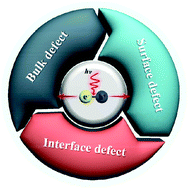当前位置:
X-MOL 学术
›
Inorg. Chem. Front.
›
论文详情
Our official English website, www.x-mol.net, welcomes your
feedback! (Note: you will need to create a separate account there.)
Defect-mediated electron–hole separation in semiconductor photocatalysis
Inorganic Chemistry Frontiers ( IF 6.1 ) Pub Date : 2018-04-06 00:00:00 , DOI: 10.1039/c8qi00122g Wei Zhou 1, 2, 3, 4, 5 , Honggang Fu 1, 2, 3, 4, 5
Inorganic Chemistry Frontiers ( IF 6.1 ) Pub Date : 2018-04-06 00:00:00 , DOI: 10.1039/c8qi00122g Wei Zhou 1, 2, 3, 4, 5 , Honggang Fu 1, 2, 3, 4, 5
Affiliation

|
Defects play important roles in semiconductor photocatalysis, which not only can act as active sites but also serve as recombination centers for electrons and holes. The rational control of defects appears to be particularly important. Defect engineering in semiconductor electron–hole separation is complex but vital for photocatalysis, and the exact control of defects still presents a great challenge. This review endeavors to clarify the inherent functionality of different defects such as bulk defects and surface/interface defects. The common defects such as oxygen vacancies and Mn+ defects have been summarized and discussed. The controllable creation of defects could lead to defect channels via defect–strain coupling, defect–defect and defect–electron interactions, which contribute to the enhancement in electronic conductivity and the separation of photogenerated electron–hole pairs. The deep understanding of defects can consolidate the fundamental photocatalytic theory and provide new insights for rationally designing defect-engineered semiconductor photocatalytic materials with satisfactory performance.
中文翻译:

半导体光催化中缺陷介导的电子-空穴分离
缺陷在半导体光催化中起重要作用,它不仅可以充当活性位点,而且可以充当电子和空穴的复合中心。合理控制缺陷似乎特别重要。半导体电子-空穴分离中的缺陷工程非常复杂,但对光催化至关重要,而缺陷的精确控制仍然是一个巨大的挑战。本文旨在阐明不同缺陷(例如体缺陷和表面/界面缺陷)的固有功能。总结和讨论了诸如氧空位和M n +缺陷之类的常见缺陷。可控创建的缺陷可能会导致缺陷的通道通过缺陷-应变耦合,缺陷-缺陷和缺陷-电子相互作用,这有助于提高电子电导率并分离光生电子-空穴对。对缺陷的深刻理解可以巩固基本的光催化理论,并为合理设计性能令人满意的缺陷工程半导体光催化材料提供新的见解。
更新日期:2018-04-06
中文翻译:

半导体光催化中缺陷介导的电子-空穴分离
缺陷在半导体光催化中起重要作用,它不仅可以充当活性位点,而且可以充当电子和空穴的复合中心。合理控制缺陷似乎特别重要。半导体电子-空穴分离中的缺陷工程非常复杂,但对光催化至关重要,而缺陷的精确控制仍然是一个巨大的挑战。本文旨在阐明不同缺陷(例如体缺陷和表面/界面缺陷)的固有功能。总结和讨论了诸如氧空位和M n +缺陷之类的常见缺陷。可控创建的缺陷可能会导致缺陷的通道通过缺陷-应变耦合,缺陷-缺陷和缺陷-电子相互作用,这有助于提高电子电导率并分离光生电子-空穴对。对缺陷的深刻理解可以巩固基本的光催化理论,并为合理设计性能令人满意的缺陷工程半导体光催化材料提供新的见解。











































 京公网安备 11010802027423号
京公网安备 11010802027423号